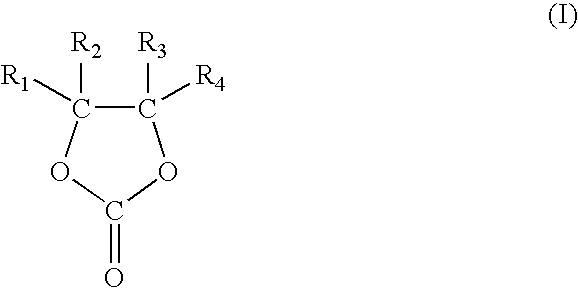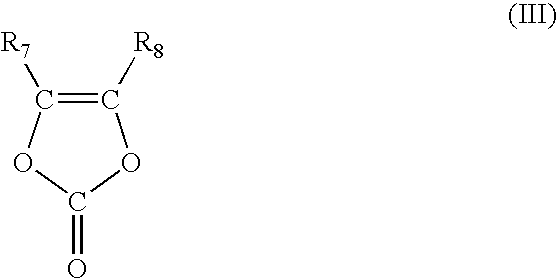Lithium Secondary Battery
a secondary battery and lithium technology, applied in the field of lithium secondary batteries, can solve the problems of deterioration of characteristics of electrodes provided with ptc functions into batteries, insufficient responsiveness of conventional technology for exhibiting function in response, etc., and achieve the effect of reliably actuating the mechanism and high safety
- Summary
- Abstract
- Description
- Claims
- Application Information
AI Technical Summary
Benefits of technology
Problems solved by technology
Method used
Image
Examples
example 1
EXAMPLE 1
Preparation of Electroconductive Materials
[0037]Carbon black (70 parts by mass) as an electroconductive agent and polyethylene carbonate (30 parts by mass) as a gas generating resin were mixed to prepare pellets. The pellets were pulverized by jet milling to obtain an electroconductive material (DD1).
[0038]Fabrication of a Spirally Wound Battery
[0039]A spirally wound battery according to the present embodiment was fabricated by the following method. FIG. 1 is a cross-section illustrating one side of a spirally wound battery.
[0040]A cathode material paste was prepared by mixing LiMn1 / 3Ni1 / 3Co1 / 3O2 as a cathode-active material, DD1 as an electroconductive material, polyvinylidene fluoride (PVDF) as a binder, and NMP (N-methylpyrrolidone) as a solvent such that the ratio of solids on dry basis was LiMn1 / 3Ni1 / 3Co1 / 3O2:DD1:PVDF=88:5:7.
[0041]The paste of the cathode material was spread over an aluminum foil that served as a cathode collector 1 and dried at 80° C., roll-pressed, ...
example 2
EXAMPLE 2
[0055]Carbon black (70 parts by mass) as an electroconductive agent, polyethylene carbonate (25 parts by mass) as a gas generating resin, and PVDF (5 parts by mass) as a binder were mixed to prepare pellets. The pellets were pulverized by jet milling to obtain an electroconductive material (DD2). Batteries were fabricated in the same manner as in Example 1 by using the electroconductive material DD2 instead of the electroconductive material DD1. Battery evaluation and safety evaluation were performed on the obtained batteries in the same manner as in Example 1. The results are shown in Table 1.
example 3
EXAMPLE 3
[0056]Carbon black (70 parts by mass) as an electroconductive agent, polyethylene carbonate (20 parts by mass) as a gas generating resin, and PVDF (10 parts by mass) as a binder were mixed to prepare pellets. The pellets were pulverized by jet milling to obtain an electroconductive material (DD3). Batteries were fabricated in the same manner as in Example 1 by using the electroconductive material DD3 instead of the electroconductive material DD1. Battery evaluation and safety evaluation were performed on the obtained batteries in the same manner as in Example 1. The results are shown in Table 1.
PUM
| Property | Measurement | Unit |
|---|---|---|
| temperature | aaaaa | aaaaa |
| temperature | aaaaa | aaaaa |
| temperatures | aaaaa | aaaaa |
Abstract
Description
Claims
Application Information
 Login to View More
Login to View More - R&D
- Intellectual Property
- Life Sciences
- Materials
- Tech Scout
- Unparalleled Data Quality
- Higher Quality Content
- 60% Fewer Hallucinations
Browse by: Latest US Patents, China's latest patents, Technical Efficacy Thesaurus, Application Domain, Technology Topic, Popular Technical Reports.
© 2025 PatSnap. All rights reserved.Legal|Privacy policy|Modern Slavery Act Transparency Statement|Sitemap|About US| Contact US: help@patsnap.com



